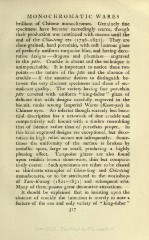Page 391 - Oriental Series Japan and China, Brinkly
P. 391
MONOCHROMATIC WARES
brilliant of Chinese monochromes. Genuinely fine
specimens have become exceedingly scarce, though
their production was continued with success until the
end of the Chia-tsing era (1796-1821). They are
close-grained, hard porcelain, with soft lustrous glaze
of perfectly uniform turquoise blue, and having deco-
rative designs dragons and phoenixes engraved
in the pate. Crackle is absent and the technique is
unimpeachable. It is important to notice these two
points the nature of the pate and the absence of
crackle if the amateur desires to distinguish be-
tween the very choicest specimens and those of sec-
ond-rate quality. The variety having fine porcelain
glaze of
pate covered with uniform " "
king-fisher
delicate tint with designs carefully engraved in the
biscuit, ranks among Imperial Wares (Kuan-yao) in
Chinese eyes. An inferior though scarcely less beau-
tiful description has a net-work of fine crackle and
comparatively soft biscuit with a timbre resembling
that of faience rather than of porcelain proper. In
this kind engraved designs are exceptional, but deco-
ration in high relief occurs not infrequently. Some-
times the uniformity of the surface is broken by
metallic spots, large or small, producing a highly
pleasing effect. Turquoise glazes are also found
upon reddish brown stone-ware, thin but compara-
tively coarse. Such specimens are either to be classed
as third-rate examples of Chien-lung and Chia-tsing
manufactures, or to be attributed to the workshops
of Taou-Kwang (1821 1851) and subsequent eras.
Many of them possess great decorative attractions.
It should be explained that in insisting upon the
absence of crackle the intention is merely to note a
feature of the one and only variety " "
of king-fisher

